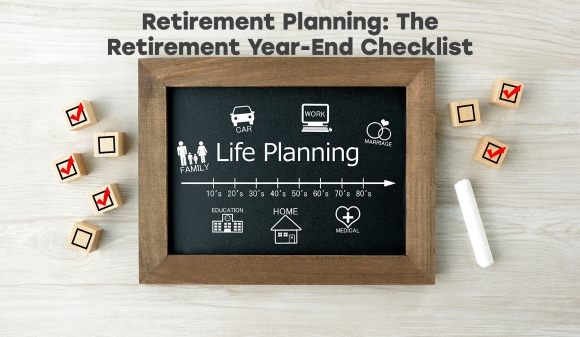Retirement Planning The Retirement Year-End Checklist

 Have you made it to retirement only to realize that it is the starting line for a whole other life? Does withdrawing from your diligently accumulated nest egg make you feel like you are doing something wrong? Do the financial management tools you mastered to get here seem ill-suited for the decades of decumulation to come?
Have you made it to retirement only to realize that it is the starting line for a whole other life? Does withdrawing from your diligently accumulated nest egg make you feel like you are doing something wrong? Do the financial management tools you mastered to get here seem ill-suited for the decades of decumulation to come?
You are not alone. The shift from working for a living to living off your savings can be long and difficult, but there is a simple, repeatable process you can follow to make this transition easier, faster, and ultimately more satisfying. It’s a process you already follow for your car, body, and furnace: the annual maintenance checklist.
Your retirement, like your car, is a complex system of interdependent mechanisms that seems to operate with only the simplest of inputs from you: accelerate, brake, and steer. Earn, spend, pay tax. And, like your car, the best way to keep every system running smoothly is to check in on them regularly—even if (especially if!) everything seems fine and nothing on the dashboard is flashing.
Step Zero: Know Your Expectations
Before you can check in on how your retirement is unfolding, you must have some idea of what you expect to happen with your income, spending, investments, and income tax; otherwise, you won’t have any way of knowing if things are going well or if you’re flirting with disaster and need to make some adjustments!
As professional financial planners, of course we think that a formal retirement income plan is worth the investment. Until you are ready for that, a homemade spreadsheet, or good online calculator will do in a pinch.
Step One: Schedule Your Appointment
Consider this an annual appointment with yourself, and schedule it in your calendar. Ideally, you want to run through your checklist in the last part of the year, when you have enough information about what’s gone on to make educated decisions about what’s likely to happen in the next couple of months.
Step Two: Assemble This Year’s Information
Now that you have a deadline to work towards, begin collecting the information you need. Start with the easy stuff that your professional advisory team can help with. Contact your financial and cash flow planner, investment manager(s), and accountant to help you assemble:
- Income:
How much have you received to date this year from Canada Pension Plan (CPP), Old Age Security (OAS), and pension benefits, Registered Retirement Income Fund (RRIF) withdrawals, and non-registered investment distributions (whether they’re reinvested or not)?
- Tax:
Calculate how much you may owe based on your income and amounts that have been withheld already. Will you have to pay the balance when you file, or should you expect a refund?
- Spending:
How much did you spend? How much are you on track to spend for the balance of the year? How much of that spending was or will be on your core, non-negotiable, minimum standard of living? How much was on the nice-to-haves or one-off large expenses?
- Portfolio:
How much money did each account start the year with and how much is left? Is this within the range of acceptable outcomes you identified in your retirement plan? If it’s outside of that range, is this the first time or has there been a consistent pattern of over- or under-performance over the last three to five years?
Step Three: Break Out The Crystal Ball
You might not know what will happen next year, but you can make some good guesses. You need to draft what you think the upcoming year might look like. Determine whether your spending will increase due to outside influences like inflation or decrease because you decided to reduce in a particular area. Think about whether there is something big coming up like a dream vacation, a vehicle or boat purchase, replacement of your appliances, or the arrival of a grandchild. Are there big deadlines coming up, like the mandatory conversion of your Registered Retirement Savings Plan (RRSP) to a Registered Retirement Income Fund (RRIF), or the last year you can defer benefits like CPP and OAS?
If you’re turning 65 in the upcoming year, you should pay close attention to your pension income, especially if you receive a bridge benefit or the CPP Disability benefit.
- Income:
What fixed sources of income will you have in the year ahead? These are likely to be repeats of last year. This may include CPP, OAS and pension benefits, a rough estimate of your RRIF minimum withdrawals, maybe some rental income or a little consulting gig.
- Spending:
What do you think you will spend? Your base lifestyle costs may or may not increase with inflation. You might need some new tires, a paint job on the fence, or a getaway someplace enjoyable. Let’s put some estimates together.
- Tax:
Knowing what we know about fixed sources of expected income, what can you reasonably expect to pay in income taxes (taking into account fun things like income splitting and tax credits)?
- Portfolio:
Knowing all the above, how much more would you need to draw from your portfolio to cover your after-tax spending plan? Assume this will be a straight withdrawal from the cash portion of your portfolio for the time being. When your portfolio makes money next year, you can adjust what is in the cash portion for the following year and reassess your taxable income in next year’s annual review.
Step Four: Fine Tune
As the year unfolds, the unexpected will happen. Along with death and taxes, change is inevitable. Keep an eye on the changes in your income (sometimes those pensions add a sweetener at the beginning or the middle of the year), your spending (do we need to stop and reassess?), your portfolio (but lightly), tax legislation (did they change the rates?), and make small changes as you go. A check-in every month on your spending and every three months on everything else—just a glance over for any red flags—will help you ensure that you’re ready for your next annual check-up.
Conclusion
International research shows that those who feel control over their retirement process are more likely to experience better retirement outcomes. But take note of the distinction: scholars differentiate between “feeling” in control and “being” in control: it is the former that seems to matter, which is a relief.
So much of your success depends on factors you cannot control, including what the markets do, and whether government policy changes, not to mention your health and cognitive ability. Your retirement maintenance checklist is designed to keep you focused on controlling the few things you can, so you can adapt to the many things that you cannot control.
Sandi Martin is COO of Spring Plans, an advice-only financial planning firm. She uses design thinking to help her clients create success on their own terms.

